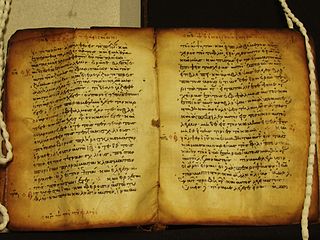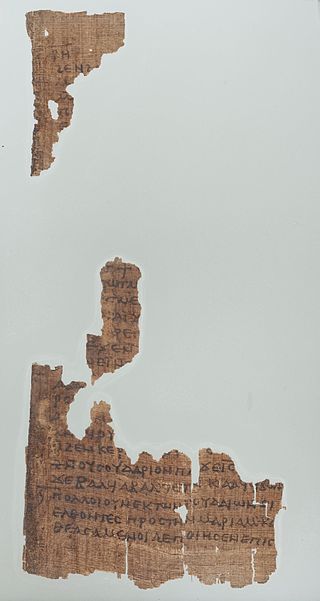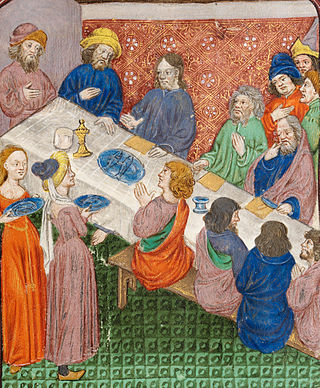- Christ and Mary Magdalene in the House of Simon, 1645, by Carlo Dolci, Nationalmuseum, Stockholm, Sweden
Related Research Articles

Mary of Bethany is a biblical figure mentioned only by name in the Gospel of John in the Christian New Testament. Together with her siblings Lazarus and Martha, she is described by John as living in the village of Bethany, a small village in Judaea to the south of the Mount of Olives near Jerusalem.

Mark 14 is the fourteenth chapter of the Gospel of Mark in the New Testament of the Christian Bible. It contains the plot to kill Jesus, his anointing by a woman, the Last Supper, predictions of his betrayal, and Peter the Apostle's three denials of him. It then begins the Passion of Jesus, with the garden of Gethsemane and Judas Iscariot's betrayal and Jesus' arrest, followed by Jesus' trial before the Sanhedrin and Peter's denials of Jesus.

Mark 1 is the first chapter of the Gospel of Mark in the New Testament of the Christian Bible. It recounts the proclamation of John the Baptist, the baptism of Jesus Christ, his temptations and the beginning of his ministry in Galilee.

Mark 3 is the third chapter of the Gospel of Mark in the New Testament of the Christian Bible. It relates a conflict over healing on the Sabbath, the commissioning of the Twelve Apostles, a conflict with the Jerusalem scribes and a meeting of Jesus with his own family.

Mark 8 is the eighth chapter of the Gospel of Mark in the New Testament of the Christian Bible. It contains two miracles of Jesus, Peter's confession that he believes Jesus is the Messiah, and Jesus' first prediction of his own death and resurrection. It is the middle chapter of the gospel but its significance is variously understood: for example the Jamieson-Fausset-Brown Bible Commentary calls it a "section of miscellaneous matter", whereas many commentators treat it as a turning point where Mark's description of Jesus as teacher and miracle worker gives way to his focus on the role of Jesus' death and the difficult nature of his teachings.

The Parable of the Two Debtors is a parable of Jesus. It appears in Luke 7:36–7:50, where Jesus uses the parable to explain that the woman who has anointed him loves him more than his host, because she has been forgiven of greater sins.

The ministry of Jesus, in the canonical gospels, begins with his baptism in the countryside of Roman Judea and Transjordan, near the River Jordan by John the Baptist, and ends in Jerusalem, following the Last Supper with his disciples. The Gospel of Luke states that Jesus was "about 30 years of age" at the start of his ministry. A chronology of Jesus typically sets the date of the start of his ministry at around AD 27–29 and the end in the range AD 30–36.

Matthew 9 is the ninth chapter of the Gospel of Matthew in the New Testament and continues the narrative about Jesus' ministry in Galilee as he ministers to the public, working miracles, and going through all the cities and towns of the area, preaching the gospel, and healing every disease. This chapter opens with Jesus back in "his own town", i.e. Capernaum.
Matthew 16 is the sixteenth chapter in the Gospel of Matthew in the New Testament section of the Christian Bible. Jesus begins a journey to Jerusalem from the vicinity of Caesarea Philippi, near the southwestern base of Mount Hermon. Verse 24 speaks of his disciples "following him".

Matthew 19 is the nineteenth chapter in the Gospel of Matthew in the New Testament section of the Christian Bible. The book containing this chapter is anonymous, but early Christian tradition uniformly affirmed that Matthew composed this Gospel. Jesus commences his final journey to Jerusalem in this chapter, ministering through Perea. It can be seen as the starting point for the passion narrative.

John 11 is the eleventh chapter of the Gospel of John in the New Testament of the Christian Bible. It records the raising of Lazarus from the dead, a miracle of Jesus Christ, and the subsequent development of the chief priests' and Pharisees' plot against Jesus. The author of the book containing this chapter is anonymous, but early Christian tradition uniformly affirmed that John composed this Gospel.

John 12 is the twelfth chapter of the Gospel of John in the New Testament of the Christian Bible. It narrates an anointing of Jesus' feet, attributed to Mary of Bethany, as well as an account of the triumphal entry of Jesus Christ into Jerusalem. The author of the book containing this chapter is anonymous, but early Christian tradition uniformly affirmed that John composed this Gospel.

Luke 7 is the seventh chapter of the Gospel of Luke in the New Testament of the Christian Bible. It tells the records of two great miracles performed by Jesus, his reply to John the Baptist's question, and the anointing by a sinful woman. The book containing this chapter is anonymous, but early Christian tradition uniformly affirmed that Luke the Evangelist, a companion of Paul the Apostle on his missionary journeys, composed this Gospel as well as the Acts of the Apostles.

Luke 8 is the eighth chapter of the Gospel of Luke in the New Testament of the Christian Bible. The book containing this chapter is anonymous but early Christian tradition uniformly affirmed that Luke the Evangelist, a companion of Paul the Apostle on his missionary journeys, composed both this Gospel and the Acts of the Apostles. This chapter mentions the women who supported Jesus and records some of the great miracles he performed, as well as several parables told by him.

The anointings of Jesus’s head or feet are events recorded in the four gospels. The account in Matthew 26, Mark 14, and John 12 takes place on the Holy Wednesday of Holy Week at the house of Simon the Leper in Bethany, a village in Judaea on the southeastern slope of the Mount of Olives. In Matthew and Mark, he is anointed by an unnamed woman. In John, the woman is identified as Mary of Bethany, the sister of Martha and Lazarus. The event in Luke features an unknown sinful woman, and is in the northern region, as Luke 7 indicates Jesus was ministering in the northern regions of Nain and Capernaum. The honorific anointing with perfume is an action frequently mentioned in other literature from the time; however, using long hair to dry Jesus's feet, as in John and Luke, is not recorded elsewhere, and should be regarded as an exceptional gesture. Considerable debate has discussed the identity of the woman, the location, timing, and the message.

Simon the Leper is a biblical figure who lived in Bethany, a village in Judaea on the southeastern slope of the Mount of Olives. He is mentioned in the Gospels according to Matthew and Mark. These books tell of how Jesus made a visit to the house of Simon the Leper at Bethany during the course of which a woman anoints the head of Jesus with costly ointment. Bethany was also the home of Mary, Martha, and Lazarus.

In Eastern Orthodox Christian tradition the Myrrhbearers are the individuals mentioned in the New Testament who were directly involved in the burial or who discovered the empty tomb following the resurrection of Jesus. The term traditionally refers to the women with myrrh who came to the tomb of Christ early in the morning to find it empty. In Western Christianity, the women at the tomb, the Three Marys or other variants are the terms normally used. Also included are Joseph of Arimathea and Nicodemus, who took the body of Jesus down from the cross, embalmed it with myrrh and aloes, wrapped it in clean linen, and placed it in a new tomb..

Jesus' interactions with women are an important element in the theological debate about Christianity and women. Women are prominent in the story of Christ Jesus. He was born of a woman, had numerous interactions with women, and was seen first by women after his resurrection. He commissioned the women to go and tell his disciples that he has risen, which is the essential message of Christianity.

The name Mary appears 54 times in the New Testament, in 49 verses. It was the single most popular female name among Palestinian Jews of the time, borne by about one in four women, and most of the New Testament references to Mary provide only the barest identifying information. Scholars and traditions therefore differ as to how many distinct women these references represent and which of them refer to the same person.

The names Simon and Simeon appear 71 times and 8 times in the New Testament, respectively. Simon was a very common given name in the historical period and region of Jesus, but surnames were still very rare. It is therefore not always clear which person these names refer to, and whether some refer to the same person or distinct characters, which has led to confusion. Therefore, Christian authors and modern scholars have given these men nicknames based on their known attributes.
References
- ↑ "The Anointing of Jesus" The Anointing of Jesus
- ↑ Whittaker H.A. Studies in the Gospels, Cannock 1996

